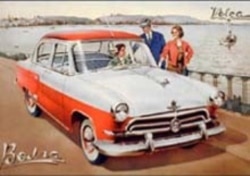
What is today known as the Russian automaker GAZ was founded in 1929. A technology-sharing agreement was reached with the U.S. Ford Motor Company and the foundations were laid for the construction of an automobile-manufacturing plant near Nizhnii Novgorod.
The company was initially known as the Niznii Novgorod Automobile Factory until it was renamed the Gorkii Autombile Factory after the writer Maksim Gorkii.
Soviet versions of Ford's venerable Model A passenger vehicle (the NNAZ A) and Model AA (GAZ AA) truck began rolling off the assembly line in 1932.
After World War II, GAZ celebrated with the introduction of the Pobeda (Victory) and followed on that success with the introduction of the GAZ-21 -- dubbed the Volga -- in 1956. The GAZ-21 Volga was the first Soviet automobile to rival the technology and construction of Western vehicles and was produced until 1970.
In 1970, the company began full-scale production of the GAZ-24 Volga, which featured a design similar to Western sedans of the era. The popular GAZ-24 found a niche as an export vehicle and a station-wagon version was introduced in 1972. Production of the GAZ-24 continued until 1992, and all variants of the Volga manufactured to this day derive from the original GAZ-24.
Attempts were made to modernize the vehicle in the early 1982 with the introduction of the GAZ-3102, which is still manufactured today. The more luxurious 3110 model arrived in 1997 and was produced in large numbers until 2003.
The most extensive remodeling of the Volga resulted in the GAZ-31105, which boasts modern, rounded styling and some foreign-made components and serves today as the luxury model of the Volga lineup.
Production of the Volga reached its peak in the 1990s, reaching more than 100,000 vehicles per year. By 2005, however, the company planned to produce only 56,000 of the vehicles.



